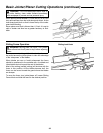
27
dust buildup around motor and switch box.
• Keep blades sharp. Dull or nicked blades tend to
“pound” and chew at the wood, causing kickbacks.
• Make sure the cutter guard works properly. With the
switch off and key removed, pull the cutter guard open
and let go. If the guard doesn’t smoothly swing closed,
contact an Authorized Service Center.
• Don’t force the tool. It will do the job better and safer at
the rate for which is was designed.
Push blocks and push sticks
Two plastic push blocks are supplied with your jointer/
planer. Use them when practical. The rubber sole of the
push blocks give better traction with the wood than your
hands do. If they become slippery, they can be cleaned
with rubbing alcohol, paint thinner or sandpaper.
WARNING: Use rubbing alcohol or paint thinner
only as described on their containers. Use only in well
ventilated areas away from open flames, sparks or
heat sources to prevent serious personal injury.
Push blocks can’t always be used. With larger work-
pieces, you may have better control of the workpiece
using your hands. Always make a test pass first to deter-
mine which method gives you better control.
Before you make any cut, plan your hand positions. If a
kickback should occur, plan so that your hands will not
fall or be forced into the cutters.
Three Inch Rule (3")
Generally, if your hands are closer than three inches to
the blade as you feed the wood, use push blocks. This
gives extra protection to your hands by placing the push
blocks between your hands and the cutters.
Always Use Push Blocks When Planing, Beveling Or
Chamfering
When jointing, test for workpiece stability before actually
jointing, and use push blocks when you can without sacri-
ficing control.
Feeding the Workpiece (All Operations)
WARNING: Plan your work carefully. Use push-
blocks for all jointing and planing operations for which
such blocks are appropriate to prevent serious per-
sonal injury.
• Support long workpieces at both infeed and outfeed,
as shown on page 30.
• Feed with grain whenever possible. When necessary
to feed against grain, take very light cuts and feed
slowly to minimize workpiece splintering, breakage or
dangerous kickback.
• Keep steady pressure down on table and back against
fence.
• As leading edge of board passes by cutterhead,
slightly shift pressure to above cutterhead and outfeed
table, away from infeed table. Keep pressure at out-
feed table and near cutterhead for remainder of cut.
• Use hand-over-hand motion, releasing forward hand
and moving it to rear, to continue feeding workpiece.
• Feed the board at a continuous rate until the cut is
made along the entire length of the board. Any hesita-
tion or stopping could cause a “step” on the edge of
the board, resulting in an uneven edge as the cut is
completed.
• If it is difficult to maintain steady rate, table or fence
may need waxing (see Maintenance Section of man-
ual.)
To Reduce the Risk of Injury From Jams, Slips Or Thrown Pieces (Kickbacks Or Throwbacks)
• Use this jointer/planer to cut only wood.
• Plan your hand placement so your fingers will not be
anywhere a sudden slip could cause them to slide or
fall into the cutter head. When using only one hold-
down/push-block to feed the wood, do not put your
other hand on the jointer/planer, workpiece, or hold-
down/push-block.
• Make sure the clamps and locks are tight and there is
not excessive play in any parts.
• To reduce the risk of injury from thrown pieces, make
sure the blades are properly installed and the cutter
blade wedge screws are tight.
• Adjust the depth of cut to between 1/32 and 1/16 of an inch
for best results in most operations. A deep cut makes feed-
ing the wood harder and can cause the wood to kickback.
To be sure you will make a depth of cut you planned,
always lower the infeed table slightly farther than you
wanted. Then, raise the table to the desired depth.
• Use The Right Tool. Don’t force tool or attachment to
do a job it was not designed for.
Inspect your work area.
• Keep work area clean.
• Cluttered areas and benches invite accidents. Floor
must not be slippery from wax or sawdust.
• To reduce the risk of burns or other fire damage, never
use the jointer/planer near flammable liquids, vapors
or gases.
• Before using the jointer/planer, clear the table of all
objects not needed to feed the workpiece.
• To reduce the risk of injury, don’t do layout, assembly,
or setup work on the jointer/planer.
• Maintain tools with care. Keep tools sharp and clean
for best and safest performance. Follow instructions
for lubricating and changing accessories.
Plan your work
• Before trying a new or little used operation, carefully
plan your hand placement. Make sure you have proper
hold-down/push-blocks, jigs, fixtures, stops, etc. ready
to use.
• To reduce the risk of injury from unsafe accessories,
use only recommended accessories.


















